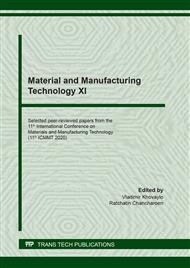p.15
p.21
p.27
p.34
p.40
p.49
p.55
p.61
p.67
Production of Bacterial Cellulose from Food Industrial Waste and its Application on Natural Rubber
Abstract:
Bacterial cellulose (BC) is high purity and several current potential uses in industries. Liquid byproduct of sweet corn canning process (SC) contains fermentable sugars which could be utilized to get higher economic benefits. Therefore, this research aimed to produce BC from SC by Gluconacetobacter xylinus under static condition and use it to improve mechanical properties of natural rubber. The ratio of SC to coconut juice for cellulose production was studied. The result revealed that production yield, water holding capacity and tensile strength of BC produced from the medium containing coconut juice to SC at a ratio of 75:25 (w/w) supplemented with 1% acetic acid, 1% ammonium sulfate and 5% sucrose (w/w) was not significant different from BC obtained from a coconut juice medium. The FTIR spectra of BC showed the characteristics of cellulose. The morphology of BC exhibited high fibril network. BC is showed reinforcement in natural rubber composites due to enhance the stress value, whereas reduce the strain value.
Info:
Periodical:
Pages:
40-45
Citation:
Online since:
February 2021
Authors:
Price:
Сopyright:
© 2021 Trans Tech Publications Ltd. All Rights Reserved
Share:
Citation:


